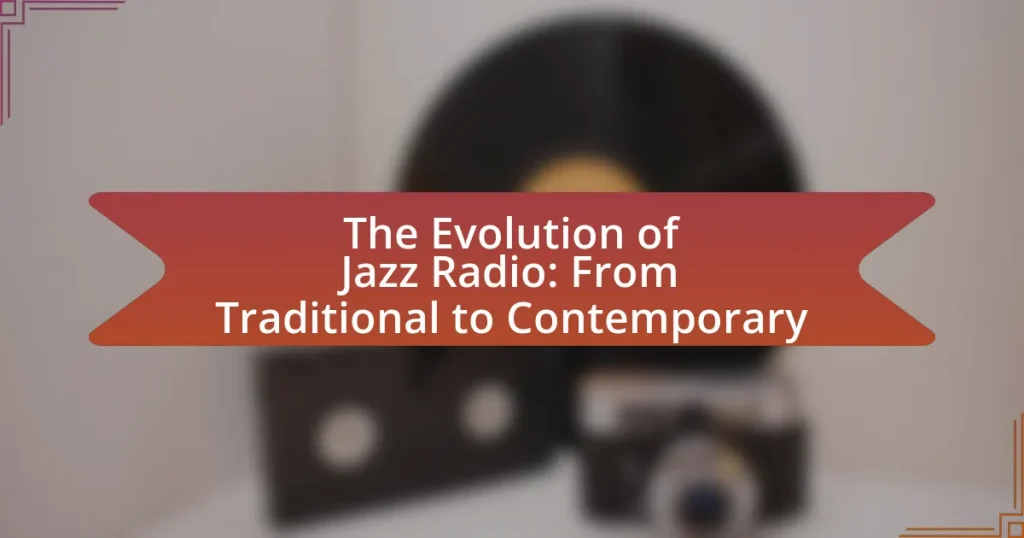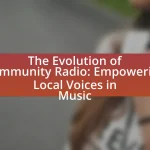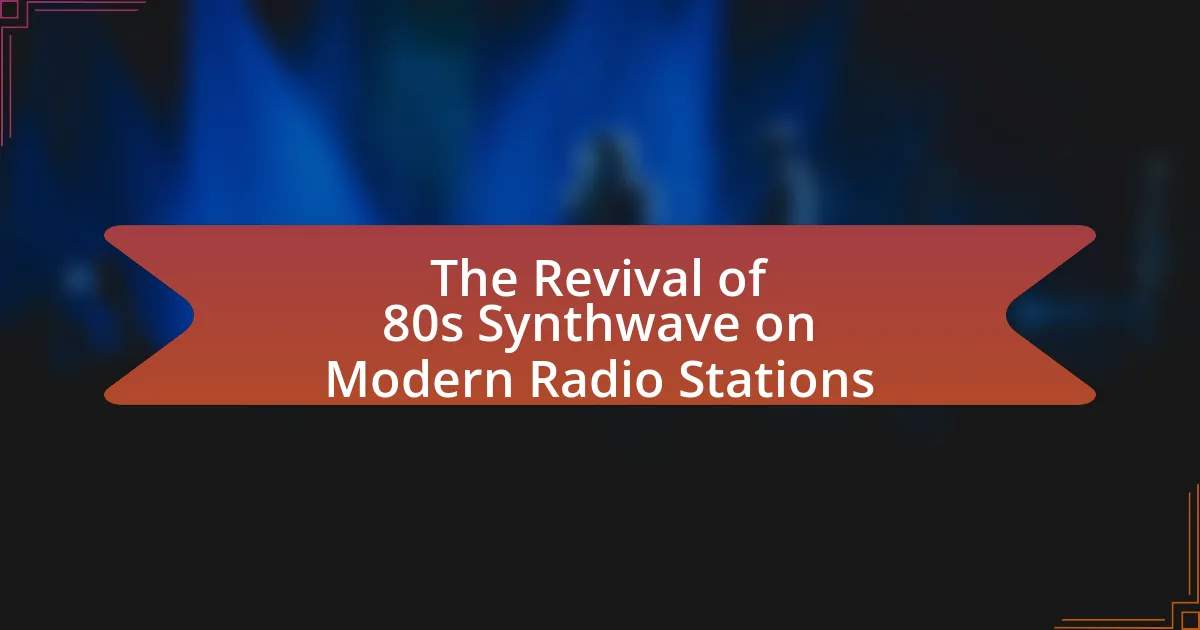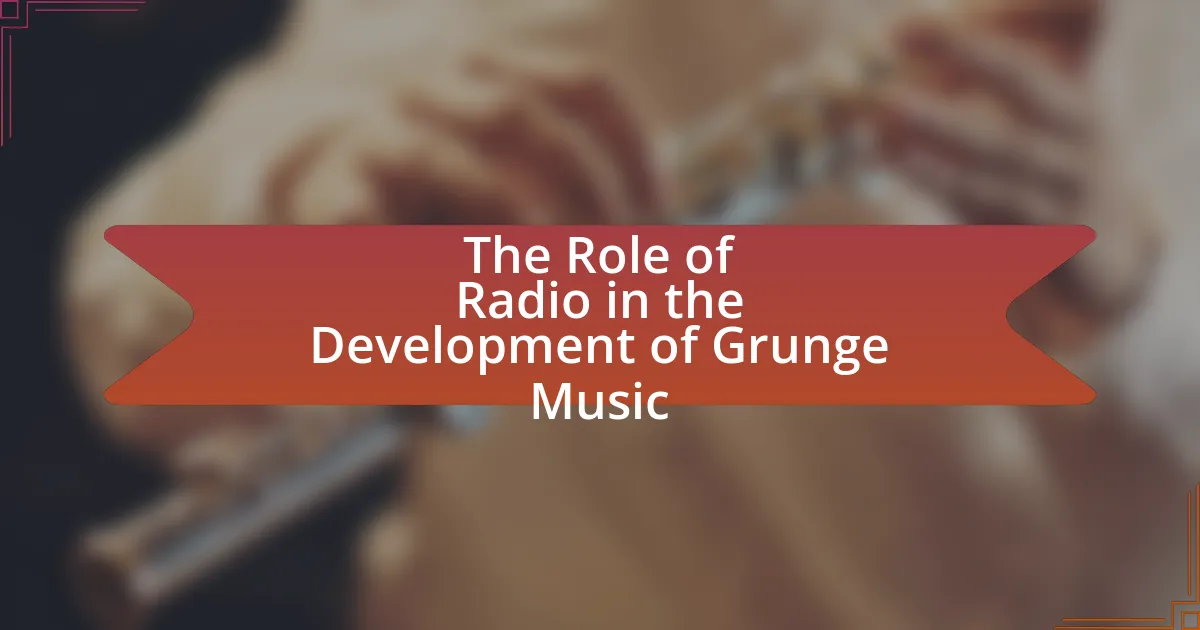The article examines the evolution of jazz radio, tracing its origins from the early 20th century to contemporary digital platforms. It highlights key milestones, such as the first dedicated jazz broadcasts in the 1920s, the rise of influential DJs, and the impact of technological advancements like FM radio and streaming services. The discussion includes the role of traditional jazz in shaping radio formats, the challenges faced by jazz radio amid competition from other genres, and the innovations brought about by the digital age. Additionally, it explores how listener preferences and emerging trends are likely to influence the future of jazz radio, emphasizing the importance of accessibility and engagement in the current landscape.

What is the Evolution of Jazz Radio?
The evolution of jazz radio began in the early 20th century, with the first broadcasts featuring jazz music emerging in the 1920s. During this period, radio stations like New York’s WEAF and Chicago’s WBBM played a crucial role in popularizing jazz by airing live performances and recordings, which contributed to the genre’s mainstream acceptance.
As jazz evolved, so did radio programming; the 1930s and 1940s saw the rise of dedicated jazz shows, such as “The Jazz Hour,” which showcased prominent artists and styles, further solidifying jazz’s place in American culture. The advent of FM radio in the 1960s allowed for higher sound quality and the emergence of specialized jazz stations, such as WBGO in Newark, New Jersey, which focused exclusively on jazz music.
In the late 20th and early 21st centuries, the rise of digital technology and the internet transformed jazz radio once again. Online streaming platforms and internet radio stations, like Jazz24 and AccuJazz, provided global access to jazz music, allowing listeners to explore diverse subgenres and artists from around the world. This shift has democratized jazz radio, enabling independent artists to reach audiences without traditional broadcasting constraints.
Overall, the evolution of jazz radio reflects broader changes in technology and culture, from early broadcasts to contemporary streaming services, illustrating the genre’s enduring appeal and adaptability.
How did jazz radio begin and what were its early influences?
Jazz radio began in the early 1920s, primarily as a means to broadcast jazz music to a wider audience. The first dedicated jazz radio program aired on New York’s WJZ in 1921, featuring live performances and recordings that showcased the genre’s emerging popularity. Early influences on jazz radio included the rise of jazz bands, such as those led by Duke Ellington and Louis Armstrong, which captivated listeners and shaped the sound of the era. Additionally, the cultural exchange between African American communities and mainstream society played a crucial role in popularizing jazz, as radio became a platform for artists to reach diverse audiences. The combination of technological advancements in radio broadcasting and the vibrant jazz scene of the time laid the foundation for the genre’s growth and integration into American culture.
What role did traditional jazz play in the formation of jazz radio?
Traditional jazz was foundational in the formation of jazz radio by establishing the genre’s core sound and cultural significance. The early 20th century saw traditional jazz, characterized by its improvisational style and ensemble play, gaining popularity in dance halls and clubs, which led to its broadcast on radio stations. This genre’s widespread appeal helped radio networks recognize the commercial potential of jazz music, prompting them to create dedicated programming that featured traditional jazz artists like Louis Armstrong and Duke Ellington. Consequently, traditional jazz not only shaped the musical landscape but also influenced the development of radio formats that catered specifically to jazz audiences, solidifying its role in the evolution of jazz radio.
How did technological advancements impact the early jazz radio landscape?
Technological advancements significantly transformed the early jazz radio landscape by enabling wider dissemination and accessibility of jazz music. The introduction of AM radio in the 1920s allowed stations to broadcast jazz performances to a broader audience, facilitating the genre’s popularity across the United States. Additionally, the development of high-fidelity sound reproduction in the 1930s improved audio quality, enhancing listeners’ experiences and encouraging more people to engage with jazz. These advancements not only promoted jazz artists but also contributed to the establishment of jazz as a central element of American culture during that era.
What are the key milestones in the history of jazz radio?
The key milestones in the history of jazz radio include the establishment of the first dedicated jazz radio programs in the 1920s, the rise of influential jazz DJs in the 1930s and 1940s, and the advent of FM radio in the 1960s which allowed for higher sound quality. In the 1920s, stations like WJZ in New York began broadcasting jazz, marking the genre’s entry into mainstream media. The 1930s saw figures like Symphony Sid and Alan Freed popularizing jazz through their shows, significantly impacting public interest. The transition to FM radio in the 1960s enhanced the listening experience, leading to the creation of specialized jazz stations such as WBGO in Newark, which launched in 1979 and remains a key player in jazz broadcasting today. These milestones collectively illustrate the evolution and growing significance of jazz radio in American culture.
Which notable figures contributed to the growth of jazz radio?
Notable figures who contributed to the growth of jazz radio include John Hammond, who was instrumental in promoting jazz artists through radio broadcasts in the 1930s, and Paul Whiteman, known as the “King of Jazz,” who helped popularize jazz music on the radio during the 1920s. Additionally, DJs like Alan Freed played a crucial role in bringing jazz to wider audiences in the 1950s, while figures such as Nat King Cole and Duke Ellington used radio to reach millions, further solidifying jazz’s place in American culture.
How did the format of jazz radio shows evolve over time?
The format of jazz radio shows evolved from simple, live broadcasts featuring local musicians to complex, curated programs that include a diverse range of jazz styles and historical context. Initially, in the early 20th century, jazz radio shows primarily showcased live performances, often focusing on regional artists and their unique sounds. As the genre gained popularity, particularly during the swing era of the 1930s and 1940s, radio shows began to incorporate recorded music, allowing for a broader selection of artists and styles.
By the 1950s and 1960s, jazz radio programming further evolved with the introduction of specialized shows that highlighted specific sub-genres, such as bebop and cool jazz, often accompanied by in-depth commentary and interviews with musicians. This shift reflected a growing interest in jazz as an art form, leading to the inclusion of educational segments that explored the history and theory behind the music.
In recent decades, the advent of digital technology and streaming services has transformed jazz radio shows into on-demand platforms, allowing listeners to access a vast library of recordings and curated playlists. This evolution has also enabled radio hosts to connect with global audiences, fostering a more inclusive and diverse jazz community. The transition from traditional formats to contemporary, multi-platform approaches illustrates the adaptability of jazz radio in response to changing listener preferences and technological advancements.
What challenges did jazz radio face during its evolution?
Jazz radio faced several challenges during its evolution, including competition from other music genres, changes in technology, and shifts in audience preferences. The rise of rock and pop music in the 1960s and 1970s led to a decline in jazz listenership, as radio stations prioritized more commercially viable formats. Additionally, the advent of FM radio and later digital streaming platforms transformed how music was consumed, making it difficult for traditional jazz radio to maintain its audience. Furthermore, the demographic shift in listeners, with younger audiences gravitating towards different musical styles, posed a significant challenge for jazz radio to attract and retain listeners. These factors collectively contributed to the struggle of jazz radio to remain relevant in a rapidly changing musical landscape.
How did competition from other music genres affect jazz radio?
Competition from other music genres significantly diminished the audience share and programming focus of jazz radio. As genres like rock, pop, and hip-hop gained popularity from the 1960s onward, jazz radio stations faced declining listenership, leading many to shift their formats to include more mainstream music to attract broader audiences. For instance, a study by the Pew Research Center in 2018 indicated that only 2% of Americans reported jazz as their favorite music genre, reflecting its marginalization in the face of more dominant genres. This shift resulted in fewer dedicated jazz stations and a reduction in the diversity of jazz programming, as stations adapted to the changing musical landscape to remain viable.
What impact did changes in listener demographics have on jazz radio?
Changes in listener demographics significantly impacted jazz radio by shifting programming strategies and audience engagement methods. As the demographic profile of jazz listeners evolved, particularly with younger audiences showing less interest, radio stations adapted by incorporating a broader range of genres and modern artists to attract new listeners. For instance, the rise of digital platforms and streaming services led to a decline in traditional jazz radio listenership, prompting stations to diversify their playlists and include contemporary jazz fusion and related genres. This adaptation reflects the necessity for jazz radio to remain relevant in a changing cultural landscape, as evidenced by the increased integration of social media and interactive content to engage younger audiences.
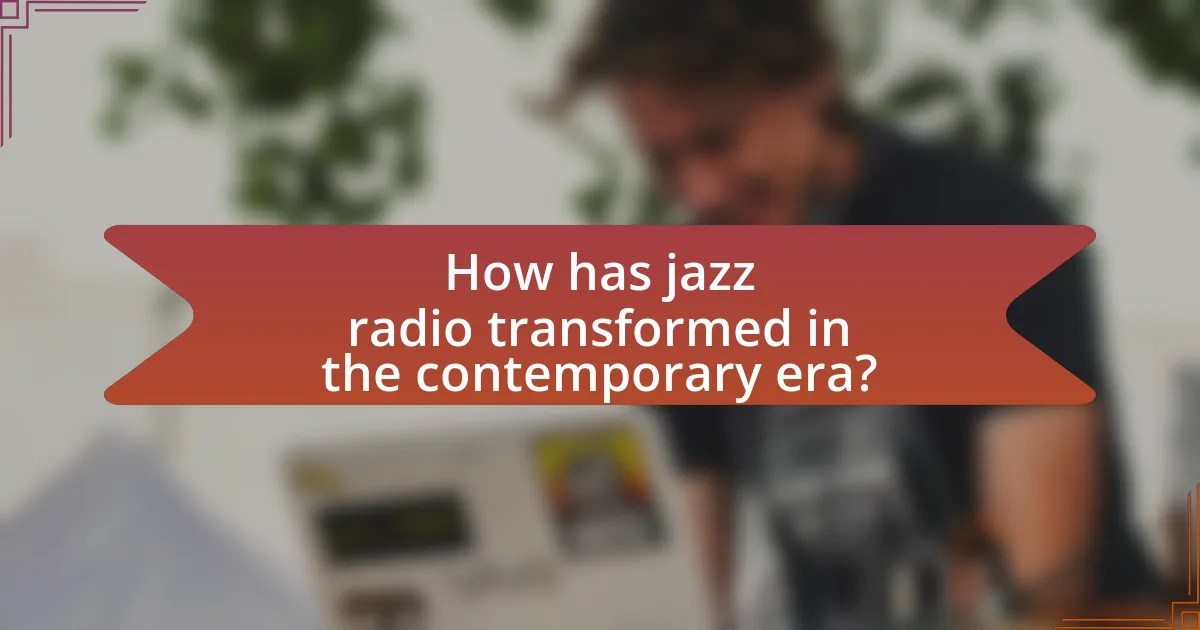
How has jazz radio transformed in the contemporary era?
Jazz radio has transformed in the contemporary era through the integration of digital platforms and streaming services, which have expanded accessibility and audience reach. Traditional jazz radio, often limited to local broadcasts, has evolved to include online streaming, allowing listeners worldwide to access diverse jazz content. According to a 2021 report by the National Public Radio, over 50% of listeners now engage with jazz through digital platforms, highlighting a significant shift from conventional radio. This transformation has also led to the emergence of specialized jazz channels and curated playlists on platforms like Spotify and Apple Music, further diversifying the listening experience and promoting new artists alongside classic jazz legends.
What are the defining characteristics of contemporary jazz radio?
Contemporary jazz radio is characterized by its diverse programming, blending traditional jazz with modern influences such as funk, hip-hop, and electronic music. This fusion reflects the genre’s evolution and appeals to a broader audience, showcasing both established artists and emerging talents. Additionally, contemporary jazz radio often emphasizes improvisation and experimentation, allowing for innovative interpretations of classic jazz standards. The integration of digital platforms and streaming services has also transformed accessibility, enabling listeners to discover a wide range of jazz styles and subgenres from around the world.
How has the digital age influenced jazz radio programming?
The digital age has significantly transformed jazz radio programming by enabling greater accessibility and diversity in content. Online platforms and streaming services have allowed jazz radio stations to reach global audiences, breaking geographical barriers that previously limited listener engagement. For instance, services like Spotify and Apple Music offer curated jazz playlists, while internet radio stations provide 24/7 access to various jazz genres and styles. This shift has led to an increase in the variety of programming, including niche genres and emerging artists, which traditional radio often overlooked. Additionally, data analytics from digital platforms allow stations to tailor their programming to listener preferences, enhancing audience engagement and satisfaction.
What role do streaming services play in the current jazz radio landscape?
Streaming services significantly enhance the current jazz radio landscape by providing broader access to diverse jazz content. These platforms, such as Spotify and Apple Music, allow listeners to explore extensive jazz catalogs, including both mainstream and niche artists, which traditional radio often overlooks. According to a 2021 report by the Recording Industry Association of America, streaming accounted for 83% of the total music industry revenue, indicating a shift in how audiences consume music, including jazz. This accessibility fosters a global community of jazz enthusiasts, enabling artists to reach wider audiences and gain recognition beyond local markets.
What innovations have emerged in jazz radio today?
Innovations in jazz radio today include the integration of streaming platforms, personalized playlists, and the use of artificial intelligence for music curation. Streaming services like Spotify and Apple Music have revolutionized how listeners access jazz, allowing for on-demand listening and the creation of tailored playlists based on user preferences. Additionally, AI algorithms analyze listener behavior to recommend tracks and artists, enhancing the discovery of new jazz music. These advancements reflect a shift from traditional broadcasting to a more interactive and user-centric approach in jazz radio.
How are social media and podcasts reshaping jazz radio?
Social media and podcasts are reshaping jazz radio by expanding its reach and diversifying content delivery. Social media platforms enable jazz artists and radio stations to connect directly with audiences, fostering community engagement and promoting events, while podcasts provide on-demand access to jazz discussions, interviews, and curated playlists. According to a 2021 report by the Pew Research Center, 41% of U.S. adults listen to podcasts, indicating a significant shift in how audiences consume audio content. This shift allows jazz radio to adapt by integrating these platforms, thus attracting younger listeners and enhancing the overall jazz experience.
What new technologies are being utilized in contemporary jazz radio broadcasts?
Contemporary jazz radio broadcasts utilize streaming technology, mobile applications, and social media integration. Streaming technology allows for high-quality audio delivery and global reach, enabling listeners to access jazz content from anywhere. Mobile applications enhance user engagement by providing personalized playlists and on-demand listening options. Social media integration facilitates real-time interaction between broadcasters and audiences, promoting community building and listener feedback. These technologies collectively enhance the accessibility and interactivity of jazz radio, reflecting the evolving landscape of media consumption.
What is the future of jazz radio?
The future of jazz radio is likely to involve a blend of traditional broadcasting and digital platforms, enhancing accessibility and audience engagement. As streaming services and online radio gain popularity, jazz radio stations are adapting by curating playlists that cater to diverse listener preferences, utilizing data analytics to understand audience behavior. According to a 2022 report by the Pew Research Center, 41% of Americans listen to online radio, indicating a shift in how audiences consume music. This trend suggests that jazz radio will increasingly focus on digital content, including podcasts and live-streamed performances, to attract younger audiences while preserving the genre’s rich history.
How might listener preferences shape the evolution of jazz radio?
Listener preferences significantly shape the evolution of jazz radio by influencing programming choices and content curation. As audiences express their tastes through listening habits, radio stations adapt by featuring specific subgenres, artists, and styles that resonate with listeners. For instance, the rise of smooth jazz in the 1980s was a direct response to listener demand for more accessible and radio-friendly music, leading to a shift in how jazz was presented on air. Additionally, data from listener surveys and streaming analytics guide stations in selecting playlists that align with current trends, ensuring that they remain relevant and appealing to their audience. This dynamic interaction between listener preferences and radio programming ultimately drives the continuous evolution of jazz radio, reflecting broader cultural shifts and audience engagement.
What trends are emerging that could influence the future of jazz radio?
Emerging trends that could influence the future of jazz radio include the integration of digital streaming platforms, the rise of personalized playlists, and the increasing use of artificial intelligence for music curation. Digital streaming platforms like Spotify and Apple Music have transformed how listeners access jazz, allowing for on-demand listening and broader exposure to diverse artists. Personalized playlists, driven by algorithms, cater to individual tastes, enhancing listener engagement and retention. Additionally, artificial intelligence is being utilized to analyze listener preferences and curate tailored content, which can lead to more targeted programming and discovery of new jazz talent. These trends indicate a shift towards a more interactive and customized listening experience in jazz radio.
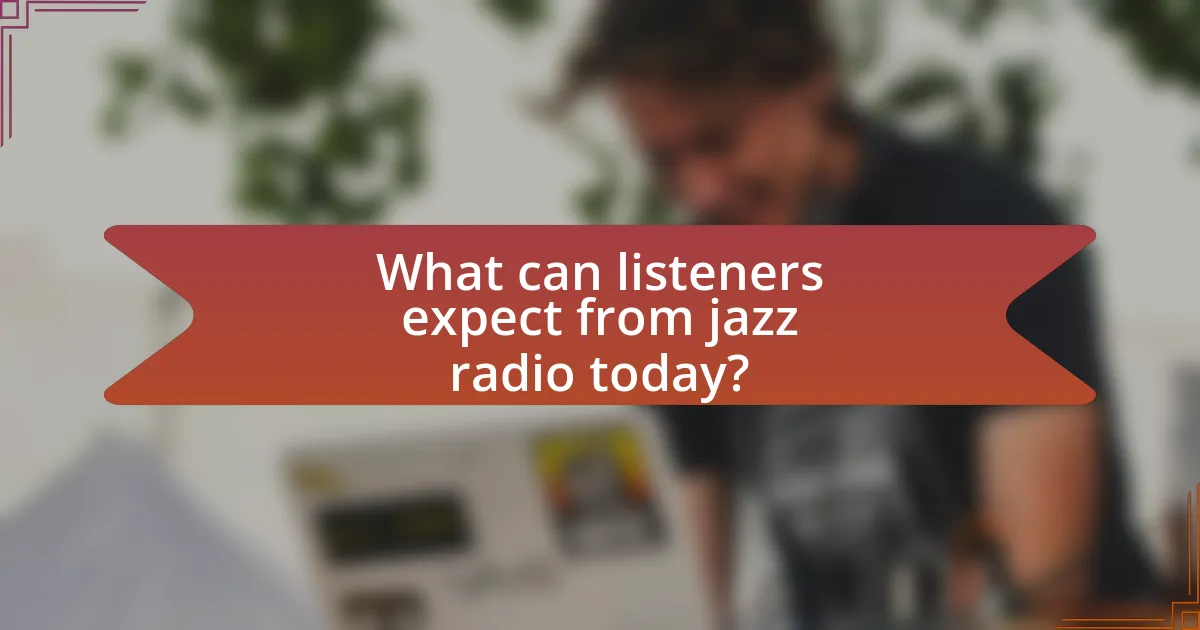
What can listeners expect from jazz radio today?
Listeners can expect a diverse range of jazz styles and innovative programming from jazz radio today. Contemporary jazz radio features not only traditional jazz but also incorporates modern subgenres such as smooth jazz, jazz fusion, and experimental jazz, reflecting the genre’s evolution. Additionally, many stations now offer curated playlists, live performances, and interviews with both established and emerging artists, enhancing listener engagement. This shift is supported by the rise of digital platforms, which allow for broader access to global jazz influences and a more personalized listening experience.
How can listeners find and engage with jazz radio stations?
Listeners can find and engage with jazz radio stations by utilizing online streaming platforms, mobile apps, and traditional radio frequencies. Online platforms like TuneIn, iHeartRadio, and JazzRadio.com provide access to a wide range of jazz stations globally, allowing listeners to explore various genres and styles. Mobile apps for these platforms enable easy access on smartphones, enhancing engagement through features like playlists and artist information. Additionally, local radio stations often broadcast jazz programs, which can be found through radio directories or by searching for specific frequencies in the listener’s area. This multi-faceted approach ensures that listeners can discover and connect with jazz radio content that suits their preferences.
What are the best platforms for accessing contemporary jazz radio?
The best platforms for accessing contemporary jazz radio include online streaming services, dedicated radio apps, and internet radio stations. Services like Spotify and Apple Music offer curated jazz playlists and radio stations, while apps such as TuneIn and iHeartRadio provide access to numerous jazz-focused channels. Additionally, platforms like Jazz24 and WBGO are specifically dedicated to jazz music, offering a wide range of contemporary jazz programming. These platforms have gained popularity due to their extensive libraries and the ability to stream live broadcasts, making contemporary jazz accessible to a global audience.
How can listeners support their favorite jazz radio shows?
Listeners can support their favorite jazz radio shows by donating to the station, participating in fundraising events, and engaging with the station through social media. Donations provide essential funding for operations, allowing stations to maintain programming and pay staff. Fundraising events, such as concerts or auctions, not only raise money but also foster community involvement. Engaging with the station on social media helps increase visibility and attract new listeners, which can lead to higher advertising revenue. According to the National Federation of Community Broadcasters, listener support is crucial for the sustainability of community radio stations, highlighting the importance of active listener participation.
What tips can enhance the jazz radio listening experience?
To enhance the jazz radio listening experience, listeners should create a dedicated listening environment that minimizes distractions. This focused setting allows for deeper appreciation of the intricate musical elements characteristic of jazz, such as improvisation and complex rhythms. Additionally, engaging with the radio station’s online resources, such as playlists and artist bios, can provide context and enrich understanding of the music being played. Research indicates that active engagement with music, including understanding its background, significantly enhances enjoyment and retention (Hargreaves & North, 1999). Therefore, by fostering an immersive atmosphere and utilizing available resources, listeners can significantly elevate their jazz radio experience.
How can listeners curate their own jazz playlists based on radio shows?
Listeners can curate their own jazz playlists based on radio shows by actively engaging with the playlists or tracklists provided by those shows. Many jazz radio programs share their playlists online, allowing listeners to identify and select their favorite tracks or artists featured during the broadcast. For example, platforms like Spotify and Apple Music often allow users to search for specific radio shows and access their playlists, which can then be saved or modified to create personalized collections. This method not only helps listeners discover new music but also enables them to build a tailored listening experience that reflects their individual tastes in jazz.
What are some recommended jazz radio shows for new listeners?
Some recommended jazz radio shows for new listeners include “Jazz Night in America,” which showcases live performances and interviews with artists, and “The Jazz Groove,” known for its extensive library of classic and contemporary jazz. “Jazz24” offers a continuous stream of jazz music, making it accessible for those new to the genre. Additionally, “The Blue Note” features a mix of traditional and modern jazz, providing a well-rounded introduction. These shows are recognized for their quality programming and ability to engage new audiences with the diverse sounds of jazz.
